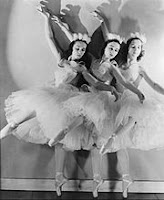Cue the longest post I have done thus far on my
blog…
I recently had the pleasure of watching the
documentary, Ballet Russes. I
absolutely loved it! Here is what I wrote right
after I watched it (from the notes I had been taking during).
Ballet
Russes, the documentary, covers the birth of modern ballet, as we know it
today. The story began with a group of young Russian girls and the infamous
choreographer and artistic director, George Balanchine. Balanchine started Ballet Russes with three thirteen-year-old
girls. The press crowned them the “three baby ballerinas.” Their names were
Tania, Tamara, and Irina. Tania was described by the others as moving lightly
like a feather but with a very defiant personality. Tamara had a very dramatic,
mysterious, sad style. And Irina had a very girly, provocative, and flirty
style. She was the most character-oriented of the three and played character
parts with authenticity and dedication.
After
training these young dancers and pulling together a troupe, Ballet Russes opened
and was received with gusto. The company was successful right away and garnered
a lot of attention. However, there were some interior tensions. Between three
choreographers, there were competing artistic visions. Michel Fokine was a
demanding choreographer who embodied a classical style. Bronislava Nijinska, a
woman, created technical, precise, and complicated pieces. And lastly, Leonide
Massine, a magnetic performer with a large international following considered
during this time period to be the greatest choreographer in the world, had a
very innovative style. Each and every ballet was individual in its
choreography, theme, mood, and story. He always wanted to push the envelope,
discover something new. Not only was Massine a gifted choreographer, but he was
also a plotter and planed to push Balanchine out and install himself as the new
artistic director.
He
succeeded and the Massine Era was born. During this time, Massine also created
thesymphonic ballet, in which a ballet is accompanied by a live orchestra, a
commodity today. Massine also hired renowned ballerina Alexandra Danilov after
she was not allowed to join by Balanchine for being too old. He featured the
male dancers more after Balanchine had said that ballet was “feminine art.”
After
a long time of being hidden from the spotlight, Wassily de Basil, an original
manager of the Ballet Russes decided to break off of the company and form his
own troupe. This started a legal battle between the two about who had ownership
over many aspects of the troupe, including the name. Massine ultimately got to
keep the name “Ballet Russes,” but de Basil countered by calling his: “The
Original Ballet Russes.”
Lichine,
a new choreographer for de Basil, and Massine proceeded to then fight over and
try to lure the dancers into their companies. Massine then won a contract from
Sol Hurok (the Hurok Contract) that sent him and his company to American on
tour.
Simultaneously,
de Basil took his company to Australia. After their tours, they both returned
to Europe and finished the season there. Shortly after the season ended, WWI
was declared, and both companies escaped to America on a ship. With both
companies in America and their popularity increasing, they both toured by train
usually traveling all day, having a performance one night at a destination and
immediately boarding the train afterwards to travel.
When
Hurok saw that de Basil’s Original Ballet
Russes was going downhill and lacked the flare of Massine’s flamboyant
choreography, he severed ties between himself and de Basil. Suddenly, the Original Ballet Russes had no more
performances as all of the theaters were controlled by Hurok. Thus began the
Latin American chapter of the Original
Ballet Russes. After garnering success in Latin America, Hurok reconnected
with the company, but unfortunately the troupe suffered a terribly received
reopening in the states. Hurok abandoned them once again. The dancers started
walking out for better opportunities. Because of a lack of funds, de Basil
started hiring unqualified dancers, and the company eventually took its last
curtain call and closed.
Meanwhile,
the Ballet Russes was garnering much success in the states. Massine, however,
eventually left the company to work as a guest choreographer at a new
competitor company called Ballet Theater. The Original Ballet Russes was left
with no choreographer or direction. After a long search, the artistic director
took a chance on a female American choreographer, Agnes de Mille, hoping that
the American audience would relate more to the performances. Agnes de Mille
produced American-themed ballets that were very well received. Critics dubbed
her ballet, Rodeo, as the true
beginning of American ballet. The dancers, however, were unimpressed with the
technicality of the choreography and how it steered so far from traditional
ballet.
After
some de Mille ballets, the Ballet Russes got a unique opportunity- a chance to
star in a major Broadway show choreographed by none other than the renowned Balanchine.
Shortly after, he returns to the company as resident choreographer. Despite his
expertise, his second career at Ballet Russes was short-lived and not well
received. Because of his traditional vision, his classical, simplistic ballets
without costumes, sets, and ‘characters’ didn’t cut it in the American
theaters. After Balanchine left, the artistic director made changes to the
company that angered many of the dancers and caused them to leave. They
overused costumes and choreography. The ballerinas got better opportunities
elsewhere. The company lost a lot of money. Finally, the Ballet Russes de Monte
Carlo closed and the dancers literally scattered across the globe. Some went
back to Europe, some to Australia, Russia, and Latin America.
Disclaimer: This
summary was basically a dry paragraph-form of the notes I took while watching Ballet Russes. These notes do NOT do the
documentary any justice. They may not even be completely accurate as it was difficult
for me to constantly digest the information flying at me. Watch the movie
(available on Netflix!). It’s amazing!





























